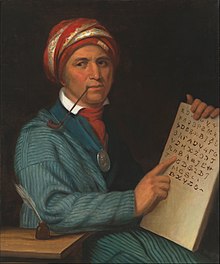
Back سيكويا Arabic سيكويا (لغوى من امريكا) ARZ Sekvoyya (Corc Gess) Azerbaijani Секвоя (правадыр чэрокі) Byelorussian Секвоя (вожд) Bulgarian Sequoyah Catalan ᏍᏏᏉᏯ CHR Sequoyah Czech Sequoyah Welsh Sequoyah Danish
This article has multiple issues. Please help improve it or discuss these issues on the talk page. (Learn how and when to remove these messages)
|
Sequoyah | |
|---|---|
ᏍᏏᏉᏯ / ᏎᏉᏯ | |
 Portrait of Sequoyah by Henry Inman | |
| Born | c. 1770 |
| Died | August 1843 (aged 72–73) |
| Nationality | Cherokee, American |
| Other names | George Guess, George Gist |
| Occupations | |
| Spouse |
Sally Benge (m. 1815) |
| Children | 2 |
Sequoyah (/səˈkwɔɪə/ sə-QUOY-yə; Cherokee: ᏍᏏᏉᏯ, Ssiquoya,[a] or ᏎᏉᏯ, Sequoya,[b] pronounced [seɡʷoja]; c. 1770 – August 1843), also known as George Gist or George Guess, was a Native American polymath and neographer of the Cherokee Nation.
In 1821, Sequoyah completed his Cherokee syllabary, enabling reading and writing in the Cherokee language. One of the first North American Indigenous groups to gain a written language, the Cherokee Nation officially adopted the syllabary in 1825,[2] helping to unify a forcibly divided nation with new ways of communication and a sense of independence.[3] Within a quarter-century, the Cherokee Nation had reached a literacy rate of almost 100%, surpassing that of surrounding European-American settlers.[4]
Sequoyah's creation of the Cherokee syllabary is among the few times in recorded history that an individual member of a pre-literate group created an original, effective writing system. It is believed to have inspired the development of 21 scripts or writing systems used in 65 languages in North America, Africa, and Asia.[5]
Sequoyah was also an important representative for the Cherokee nation; he went to Washington, D.C., to sign two relocation-and-land-trading treaties.[6]
- ^ Cite error: The named reference
Wilford-2009was invoked but never defined (see the help page). - ^ "Cherokee Traditions | Language & Literature". www.wcu.edu. Retrieved 4 May 2024.
- ^ "Sequoyah | Biography & Facts". Encyclopedia Britannica. Retrieved 19 March 2021.
- ^ Spring, Joel H. (2004). Deculturalization and the struggle for equality : a brief history of the education of dominated cultures in the United States (Fourth ed.). McGraw. p. 26.
- ^ Unseth, Peter (1 January 2016). "The international impact of Sequoyah's Cherokee syllabary". Written Language & Literacy. 19 (1): 75–93. doi:10.1075/wll.19.1.03uns. ISSN 1387-6732. Retrieved 11 February 2022.
- ^ "Sequoyah | The Encyclopedia of Oklahoma History and Culture". www.okhistory.org. Retrieved 19 March 2021.
Cite error: There are <ref group=lower-alpha> tags or {{efn}} templates on this page, but the references will not show without a {{reflist|group=lower-alpha}} template or {{notelist}} template (see the help page).